| This document is available in: English Castellano Deutsch Francais Portugues Russian Turkce |
![[Photo of the Author]](../../common/images/Ismael-R.gif)
by Ismael Ripoll <iripoll(at)disca.upv.es> About the author: Ph.D. from the Polytechnic University of Valencia in 1996. Professor in operating systems at the Department of DISCA . Research interests include real-time scheduling and operating systems. Linux user since 1994. Hobbies: Trekking through the Pyrennes mountains, skiing, and home electronics. Translated to English by: Javier Cano Perez <jcano(at)iti.upv.es> Content: |

Abstract:
This is the second article on the office suite StarOffice. In the first, once we had gone over the whole suite, we focused on designing presentations. Now, with the second article on this series, we will face the star tool on every office suite: the text editor.
Only two months ago I wrote the previous article. Since then, three reviews (service packs) of StarOffice suite have been made public by StarDivision.(http://www.stardivision.com). However, they are more likely a new and whole installation than a patch on the distribution. Program stability have been improved by large, and now every function works properly. Spanish and Catalan special symbols (accents and dieresis) are perfectly recognized, so I expect other country keyboards will be equally well handled. This distribution comes with a fully installation manual (both in html and pdf), where there are answers for every problem that could come up.
In the previous article on this series
I made a mistake with the data. I wrote that StarOffice design had been made
thinking on portability, and that only 20% code was dependant on the O.S.
That was true on version 3.1, however in the current version, that's
4.0, only 0.5% is dependent on the platform. Correction pointed out by
Michael, from StarDivision.
I am not interested here in providing with a tutorial of this word processor, but making a description of the possibilities of this tool. There are hundreds of books, and I say that seriously, in which you could find in detail how to take advantage of word processors.
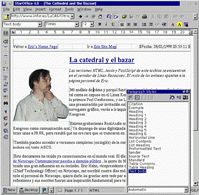
Let's go now to the working environment.
The working window is composed by the next elements:
Function tool bar. Not only cut-paste, undo-do and printing, but also a button set for navigating and other advanced functions that we will deal with later.
Object tool bar, where all the buttons related with basic edition of the working object are placed. For example: if a text is being edited, the letter type, size, bold, italic, align, ... buttons appear; if we select a drawing, the previous buttons are replaced with the align, round text distribution, borders, location point, ... buttons.
Main tool bar. From which we could insert a great part of the available objects: tables, control fields, OLE objects, drawings, active controls, etc. In the same bar we will also find out auto-text, auto-format, orthography and search functions.
Status bar. On the right, there is an info box of the current
state of the document. As it happens with the Word, the information shown
on it can also be modified. On the left, appears a hot button for creating
documents and another one that will carry us directly to the root desktop;
after
that, all open documents are shown as buttons (texts, presentations,
spreadsheets,
web pages, etc.). This is very similar to the Windows 95 toolbar with
the "Start" button.
These are the tools as they appear after installation, but we can configure them as we like, adding or eliminating buttons on each of the previous bars, or even creating new bars. We can easily configure bars location by drag'n'drop them on the desktop as we prefer (except control and menu bars that are fixed at the bottom and upper, respectively).
URL addresses are used to refer documents, both local and remotes.
First of all we have to create a new document. This can be done in four different ways:

 With the help of the assistant, from the File menu. StarOffice provides
us with 10 assistants in order to create the next type of documents: Letters,
Fax, Schedules, Memories, Presentations, Web pages, Tables, Summaries,
Forms and queries.
With the help of the assistant, from the File menu. StarOffice provides
us with 10 assistants in order to create the next type of documents: Letters,
Fax, Schedules, Memories, Presentations, Web pages, Tables, Summaries,
Forms and queries.Online help is available by means of help balloons. We have also the option to activate extended help balloons (Help > Extended_Tips) for a full and detailed help.
I have divided in three the functionally provided by StarOffice. Depending on your knowledge of word processors and your needs, you could pass over some of the next sections.
It has all basic functionality for working
on font format. Hot buttons are placed in the object tool bar for
accessing most used attributes.
![]()
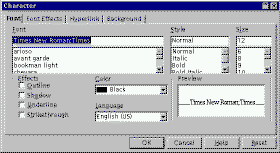 Font
type, size, bold, italic and underlined.
Font
type, size, bold, italic and underlined.
This and other attributes can be accessed and modified from the contextual menu. From the menu bar (Format>Character) you can order a beer and a beef steak, but talking about StarOffice you must resign to open a dialog window from which you have access to every attribute.
Nothing lacks respect to the paragraph format. In the object bar, close to the button set of bold, italic, etc., we have another button set used for aligning, enumeration or itemize selecting and paragraph indenting. It is also possible to change the paragraph attributes from the contextual menu and from the menu bar. Tabulation points management is exactly done as in the Word: making use of the horizontal rule.
 Hands up all of you who have ever get in trouble when configuring
the page format with the Word. Weirdly?, the Word distributes the
page format among several dialog windows, which at the same time are accessed
from different points in the menu hierarchy. Luckily for us, StarOffice
provides with a single page in order to modify at a time all page
characteristics:
Format > Page.
Moreover, some of the most used operations can also be found in the main
tool bar. From this point, page type (Letter, A3, A4, etc.), heading and
bottom size, border style, background color and column number and style
(in case of a text with two or more columns).
Hands up all of you who have ever get in trouble when configuring
the page format with the Word. Weirdly?, the Word distributes the
page format among several dialog windows, which at the same time are accessed
from different points in the menu hierarchy. Luckily for us, StarOffice
provides with a single page in order to modify at a time all page
characteristics:
Format > Page.
Moreover, some of the most used operations can also be found in the main
tool bar. From this point, page type (Letter, A3, A4, etc.), heading and
bottom size, border style, background color and column number and style
(in case of a text with two or more columns).
Printing options are fairly scarce, as only PostScript printers are supported. Anyway, providing we have well configured the system with a proper filter (normally gs will be) in the file /etc/printcap, we should be able to print without any other problem.
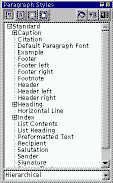
One of the first characteristics that word processors incorporated were the style set. Styles are sets of attributes --of font, of paragraph or both-- grouped in a name. For example, we can define the style "title" as Helvetica font, 14pt, bold and italic. Each time we need to create a new title we'll just assign to it the "title" style. Advantages are clear:
StarOffice offers a whole predefined style set that we can use in case we don't want to create them ourselves.
Accessing of a wide range of styles
is very interesting in order to allow us to choose a proper one when
writing any kind of document, on the other hand, it isn't a good
idea having to scan the style we have chosen in the long list of available
styles. The way in which StarOffice shows styles it quite good. Styles
that have been applied to the document are shown in a pull down list in
the object bar, so we only need to search them one time in the global style
list. Apart from this, the global style list (that we can activate
pressing
the ![]() button) allow us to organize it in different ways: automatic (taking into
account the template document StarOffice selects the best styles); all
the styles; applied styles; HTML styles; user styles; or in a hierarchy
tree.
button) allow us to organize it in different ways: automatic (taking into
account the template document StarOffice selects the best styles); all
the styles; applied styles; HTML styles; user styles; or in a hierarchy
tree.
Not only is the set of styles that we want to have available configurable, but also styles are organized depending on the main attribute defined by them: paragraph, font, page or frame style. However, paragraph styles are the most useful.
We have access to a good synonym dictionary. At the moment, only English and German versions are available.
Tables are another expected feature of every good word processor. A curiosity that called my attention in the Word is that it can't join cells vertically. Here, we haven't that drawback.
 Another thing I missed in Word is the little computing power achieved
in its tables, in other words, a Word table is very far from being used
as a spreadsheet --among other things, it seems to me that in this way
the user is encouraged to purchase a spreadsheet--. Text editor tables
(nothing to do with the spreadsheets in this suite) are real spreadsheets,
object bar changes to a full interface to help inserting formulas in the
cells. The mouse can help us to select sets of cells when building
formulas.
Another thing I missed in Word is the little computing power achieved
in its tables, in other words, a Word table is very far from being used
as a spreadsheet --among other things, it seems to me that in this way
the user is encouraged to purchase a spreadsheet--. Text editor tables
(nothing to do with the spreadsheets in this suite) are real spreadsheets,
object bar changes to a full interface to help inserting formulas in the
cells. The mouse can help us to select sets of cells when building
formulas.
Frames are used to place text and other objects inside a page with total freedom. Any object we want (table, image, text, etc.) can be inserted in a frame. A frame behaves as an object container, in such a way that if we move the frame, all objects in it will also move with the frame. Object distribution inside the frame search the same behavior that in a normal page.
There are two different ways to organize
text in different columns:
(1) apply column distribution to all
the document;
(2) create a column structure inside a floating frame. With
the second scheme we avoid the tedious method used in the Word to achieve
documents with different number of columns in two pages.
Once all document has been written, paragraphs can quickly be organised by holding <Ctrl> key down, and moving it with the cursor keys (same as <Shift>-<Alt> in the Word).
Mathematics expressions can be created well with a help option menu, or writing them in a very similar way than working with LaTeX. This expression:
sum from {i le t le n} { 1 over {x_i + y_i } b_{ij} } = {prod from {k %notequal i} x_k - x_k } over {prod from {k %notequal j} x_k - x_k }
gives as result the next FORMULA:
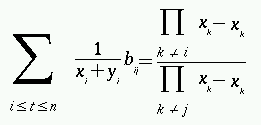
One curious possibility is that of inserting animated text. This text shifts horizontally with a uniform movement, appearing from the right and then looping. With these kind of objects, a document becomes lively and funny.
We can insert a great variety of controls (buttons, mark cells, text fields, etc.) similar to those used in HTML forms. Once inserted , they behave as active objects. We can assign a macro (written in StartBasic or JavaScript) to some object action. It is similar to forms or visual programming.
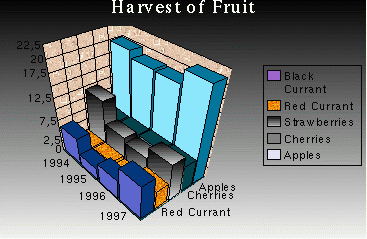 From a number table, we can produce a bar graphic. I won't introduce
all the options offered by StarOffice to draft and create the bar graphic,
as I would like to finish this article before next version comes out. I
will only
remark that bar graphics are OLE objects and identically that happens
in Windows, all program menus become embedded in the application menus.
From a number table, we can produce a bar graphic. I won't introduce
all the options offered by StarOffice to draft and create the bar graphic,
as I would like to finish this article before next version comes out. I
will only
remark that bar graphics are OLE objects and identically that happens
in Windows, all program menus become embedded in the application menus.
Aside from the bar graphic, that it is an OLE object, we can also insert another objects: a spreadsheet, a presentation or an image.
Only long experienced users in the Word try to use styles. The situation in StarOffice is completely different; the style concept is perfectly integrated with the edition. Creating an style is as simple as selecting the object we want to use as pattern (a paragraph, for example) and press the style creation button (placed in the style window), then we give a name for it, and there you are, a new style has been created. From now on, this new style will appear in the style window. It's clear that this method makes unnecessary the "copy style" button of the Word, moreover, if we think about it we'll realize that this button is actually a patch to the style system. Modifying an existing style it's equally simple; you select the object with the set of attributes desired and then press the update style button (when modifying a paragraph style remember to select the final paragraph symbol, which has the attributes of the paragraph).
The navigator (![]() )
is a window in which all the objects enclosed in the document are listed
and divided in classes: Headers, tables, frames, drawings, OLE objects,
marks, sections, bibliographic references, links, indexes and notes. From
this window we can "navigate" through the text, getting the cursor at any
of these objects.
)
is a window in which all the objects enclosed in the document are listed
and divided in classes: Headers, tables, frames, drawings, OLE objects,
marks, sections, bibliographic references, links, indexes and notes. From
this window we can "navigate" through the text, getting the cursor at any
of these objects.
The explorer and "beamer" mix allow us to scan all the disk files, included the graphic library that comes with StarOffice, and insert them in our document only by dragging and dropping them from the "beamer" window. New folders can be added (with the contextual menu) to the initial ones shown in the explorer if we need them. A file search facility is provided with the explorer in case we need its services.
![]() At least, there is no need to worry about when handling large documents.
Each chapter goes to a different document and then all them are gathered
in a master document. The master document is an special kind of
document composed of links to all the docs that support each different
chapter. It's in the master document where all the page attributes are
defined (headings, foot page, width and height, etc.), ignoring any other
individual page attribute. The master document is the base to create content
tables and indexes. As it is yet used in StarOffice, a window is provided
with the tools needed to easily "navigate" along/through the documents
composing the master document. Every moment we have a whole sight of the
final document.
At least, there is no need to worry about when handling large documents.
Each chapter goes to a different document and then all them are gathered
in a master document. The master document is an special kind of
document composed of links to all the docs that support each different
chapter. It's in the master document where all the page attributes are
defined (headings, foot page, width and height, etc.), ignoring any other
individual page attribute. The master document is the base to create content
tables and indexes. As it is yet used in StarOffice, a window is provided
with the tools needed to easily "navigate" along/through the documents
composing the master document. Every moment we have a whole sight of the
final document.
This is the working method: first, a new master document is created, then each document with a chapter needs to be dragged from the "beamer" to the "navigator", after that, indexes are inserted and, finally, headings and page numbers are arranged. The document is ready for printing. In case we wanted to change anything at the very last moment, it could be easily done by double clicking on the document, fit in the navigator we want to modify and edit it in a different window. In order to perfectly join all documents (for example, if we need a blank page between two chapters) we can add text in the master document.
Service pack3 has come up to the expectations of the most expedient Linux user when considering the program robustness and the quality of the facilities provided in it (users which find the reset button as something useless).
Considering the hardware requirements to get run StarOffice, it has to be said it isn't a specially little program. As we can see here:
ps -m | grep soffice PID TTY MAJFLT MINFLT TRS DRS SIZE SWAP RSS SHRD LIB DT COMMAND ... 302 1 22258 6063 3248 32812 50064 14004 36060 18096 0 4460 soffice.bin
the program is using up to 50Mb, taking into account that it is running on 64Mb RAM machine.
At the other hand, taking aback you provide it with enough memory, StarOffice will reward us with a high execution speed, both in basic edition operations and complex ones (like working with tables, objects, OLE or moving over large documents). All these operations can be performed without any perceptible delay. StarOffice is specially good at printing speed, as it has the ability of printing a document bigger than 100 pages in a few seconds.
This article lacks a lot of working capacities of StarOffice to be shown, but I believe the reader could imagine quite well what can expect from this suite.
This word processor, StarOffice, perfectly supplies the needs of any user, and even offers some DTP (Desktop Publishing) facilities. Thanks to the range of formats (RTF, HTML, Word6.0/95) accepted by its import/export capacity, you won't have the drawback of loosing old documents when trying to change to this suite. From the point of view of the program interface, handling and implemented functionality's, they are comparable to those offered by MsWord97; on the other hand (and luckily for us), referring to reliability and robustness StarOffice comes up better.
Interesting links:
StarDivision: http://www.stardivision.com
Caldera: http://www.caldera.com
First article in the series: StarOffice I
|
Webpages maintained by the LinuxFocus Editor team
© Ismael Ripoll , FDL LinuxFocus.org |
Translation information:
|
2002-10-23, generated by lfparser version 2.32